
Month: September 2017





:fill(FFCC00,1)/about/Marshall-56a48cce5f9b58b7d0d7816e.jpg)

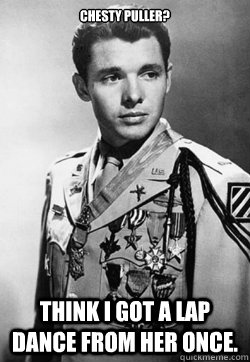
The Bren Gun

One of the only guns that I know of that had its own designed in mind vehicle. The Bren carrier

**Trigger Warning, Some serious bragging is coming up**
Now I have seen this machine gun a couple of times. Once at the Imperial War Museum in London. Where I was allowed to pick it up. Somebody trying to & did win a Victoria Cross in WWII Burma
At 22 pounds, I really feel sorry for the poor guy who had to hump this on a route march of any distance. The other time at a Machine Gun shoot at a very hot and nasty place.
From what I saw about it was that it was a pretty good squad machine gun for its time. Frankly I think that it was almost as good as the M-60 MG. That I served with in the Army.
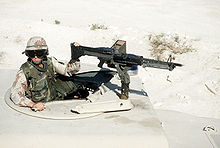
Now here is a couple of strange things that I noticed about it. Because the British / Commonwealth / Empire Army was stuck with the 303 Enfield Rimmed Round. It had to use and curved magazine that is mounted on top.
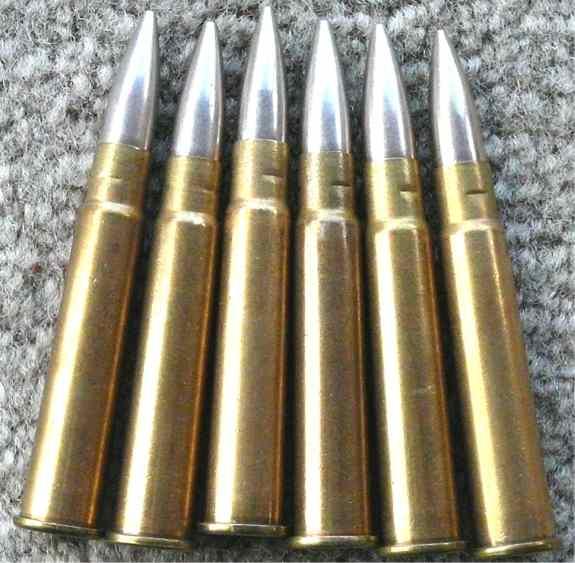 So when you cranked off a round. Gravity would help in both ejecting and feeding it another round. Pretty smart thinking says I.
So when you cranked off a round. Gravity would help in both ejecting and feeding it another round. Pretty smart thinking says I.

I am also willing to bet that it was mighty useful that both the Rifleman and the Bren Gunner used the same ammo. Always a good thing when high speed metal is flying around.
The other thing that struck me about this gun. Is the sight system that it uses. Because of the magazine blocks a straight view across the barrel. The sights have to be offset on the right hand side. 
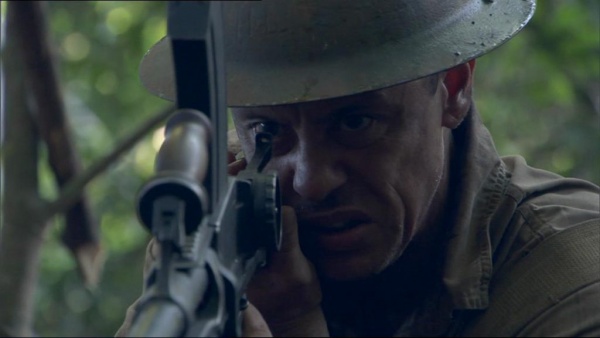
Now for some good news! First off way the Troops found that the Bren was too accurate! In that a good man could literally & consistently put a round thru the same hole. Again & again.
So a smart Trooper would hold on to a worn barrel. In order to get a better pattern when time came for suppressive fire.
Also after the war. The British Army wisely kept this gun inservice right up to the Falklands War in the early 1980’s. But wisely had it rebarreled in the 308 NATO round. I am told in this form it also gave the Crown great service. Notice the straight magazine compared to the earlier model. As the 308 round is rimless.
Notice the straight magazine compared to the earlier model. As the 308 round is rimless.
Here below is some more good stuff about this stout Warrior
WW2 Weapons: The Bren Gun
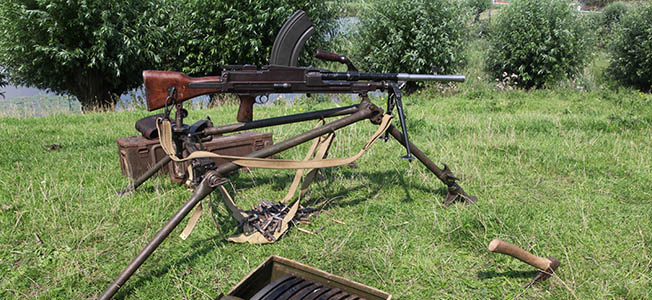
One of the most iconic British WW2 weapons today, the Bren Gun was in short supply in 1939 but quickly became the backbone of the British infantry.
by Arnold Blumberg
While all the combatant nations engaged in World War I fielded machine guns during the conflict, the British Army’s Vickers was arguably the best medium machine gun of the war, while their Lewis gun—an American design but perfected by the English—was the most effective light machine gun.
However, both weapons had their problems. The Vickers Machine Gun was a heavy Maxim-type weapon. Water-cooled and belt-fed, it was very reliable. But it was also a very complex war tool requiring a specially-trained crew, and the weight of the gun and the prodigious amount of water and ammunition it required meant the Vickers was restricted to a purely static defensive role.
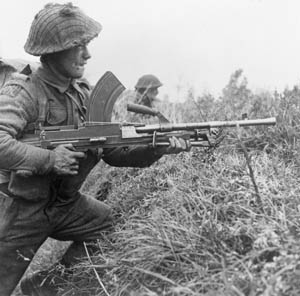
The Lewis gun had been adopted during the Great War to provide close support for advancing troops. It had an air-cooled barrel and fired .303 caliber bullets from a 47-round pan magazine mounted on the top of the piece. Unfortunately, the Lewis gun was still relatively bulky, complicated, suffered from a high rate of stoppages, and could not maintain sustained rates of fire due to its barrel overheating, causing the gun to simply stop working.
Replacing the Vickers & Lewis
Faced with the shortcomings of their standard medium and light machine guns, the British Army sought to replace both in the 1930s. That year, a contender to replace the Lewis gun appeared in the form of the Zb 26: a light, air-cooled, magazine-fed weapon produced by the Brno Firm of Czechoslovakia. Modified to shoot the standard British Army infantry and machine gun .303 caliber ammunition (or 7.7x56mm), the gun—now designated the Zb 30, with a 30 round curved magazine—caught the attention of the Small Arms Committee. After a few minor alterations, the Czech fire arm-called the ZBG 34, was adopted by the Army. Referred to as the BREN, from “Brno” and “Enfield”, assembly lines were set at the Royal Small Arms Factory in 1935, with the first finished product appearing in September 1937.
Introducing the Bren Gun
The original Bren gun was designated the Mark 1. It was capable of semi or fully automatic fire from a distinctive curved top-mounted 30-round magazine. It was 45.5 inches in overall length, and employed a quick-change 25-inch barrel, which could be replaced in seconds, allowing it to keep up a sustained rate of fire. The Bren gun used a magazine rather than the better belt-fed system due to the theory (proved incorrect by the Germans with their MG 34 and MG 42s) that the former made the weapon more portable. The piece weighed 22 pounds and 3 ounces, and fired 500 rounds per minute.
Throughout the Second World War, the Mark 1 Bren was modified three times to include the models Mark II, Mark III, and Mark IV. The same .303 caliber ammunition as the Mark 1 was used, so the differences between these patterns were a few pounds of weight and inches shaved off the later model’s overall length and barrels. In mid-1944, the Bren was standardized as the Mark III with a full length of 42.9 inches, barrel length 22.25 inches, and weighing 19 pounds and 5 ounces. Its effective range was 600 yards. It was essentially a lightened Mark 1, but fitted with a simpler ladder back sight of the Mark II, a shorter and lighter barrel (which reduced accuracy) and simpler butt. Over 57,600 Mark IIIs were produced during the war.
Backbone of the British Infantry
 During World War II, the Bren gun became the backbone of the British infantry. Every infantry section of ten men (equivalent to an American rifle squad) and its combat tactics were built around the Bren light machine gun, with the section’s riflemen tasked with augmenting the firepower of the Bren. Each infantry section contained a seven-man Rifle Group, and a three man Bren gun Group. In addition to carrying extra Bren gun ammunition, the Rifle Group would provide security and replacements for the Bren gun crews, while the Bren gunners provided the main killing power of the infantry section.
During World War II, the Bren gun became the backbone of the British infantry. Every infantry section of ten men (equivalent to an American rifle squad) and its combat tactics were built around the Bren light machine gun, with the section’s riflemen tasked with augmenting the firepower of the Bren. Each infantry section contained a seven-man Rifle Group, and a three man Bren gun Group. In addition to carrying extra Bren gun ammunition, the Rifle Group would provide security and replacements for the Bren gun crews, while the Bren gunners provided the main killing power of the infantry section.
In addition to the Bren in each infantry section, every infantry battalion included a carrier platoon made up of 13 Universal Carriers (unofficially called “Bren Gun Carriers”) in four sections of three vehicles each. Each conveyance carried a Bren gun and a three-man crew. Further, support units (ie,. supply, artillery) carried on their rosters Brens for close defense and anti-aircraft protection.
Bren guns were integral in anti-tank warfare. Although not able to knock a tank out with their small arms ammunition, their fire would cause the enemy tank crews to “button up,” limiting their fields of vision, and dispersing opposing infantry supporting the tanks. Anti-tank weapons could then be brought to bear on the steel monsters with less risk to the attackers.
Useful in the Far East and Western Front
When war broke out on September 1, 1939, the Bren had only been recently adopted by the British Army and was in short supply. After the British evacuation of France in June 1940, only 2,300 Bren guns were available for service. A chronic shortage of the weapon persisted until late 1942, when production of the gun by the UK, Canada, and Australia made up the shortfall. By war’s end Bren guns were in plentiful numbers with all British combat divisions: 1,262, 1,376, and 966 in infantry, armored, and airborne, respectively.
In the Far East, Commonwealth soldiers appreciated the Bren’s portability, as much of the fighting took place in swamps and the jungle and where the armament’s heavy caliber rounds could easily penetrate the thick vegetation. The Australians took to the Bren very quickly, using it as a heavy automatic rifle rather than a machine gun.
When the Allies landed in Italy in 1943, and then in France the next year, the Bren was not affected by the bitter winters found in those theaters of the war. More importantly, it allowed the British infantry, still equipped with bolt-action Enfield Rifles, to maintain a respectful rate of fire compared to the Americans’ use of the semi-automatic Garand Rifle, and the Wehrmacht’s employment of the excellent MG-42 Light Machine Gun.
The Bren gun, in its last incarnation—the post-World War II L4A4—was effectively removed from active service in the mid-1980s being replaced by the L86 Light Support Weapon. While never completely replacing the Vickers, the Bren did serve as the primary support arm for British and Commonwealth troops through World War II and Korea, and set the British small-unit infantry tactics on a path they would follow until the 1980s.
Originally Published January 20, 2015
Makes sense to me!

A Plea for Help!
Thank you for reading my Humble Blog!


Now that I have finally escaped & gotten my Pension. Here is a few things that I have observed about the Job.
- It is one of the toughest jobs that you will love & hate at the same time.
- There is no magic tricks to make it easier!
- There are may folks getting paid to be a teacher. But there are actually very few of us.
- The Kids stay the same. You however get older every year.
- The Administrator is not your friend
- There is a lot more to the job than most folks think there is.
- We get blamed for all of Society’s problems
- A lot of us have a SECOND Job so that we can pay our bills.
- A lot of us die soon after retiring
- You need to have the Patience of Job, The toughness of a Drill Sgt and the sense of humor of Robin Williams.
- The clock starts to go backward near final class time
- You will always not have enough work for the kids to do! For the last 20 minutes of class.
- Your Supervisor will always show up when your class is at its worst.
- A Real Veteran Teacher knows when the next School Holiday is coming.
- Sadly quite often you are the only Responsible Adult that your students know.
- You will know that you are doing a good job. When one of your students ask for your advice on something outside of School time.
- You will know also that you are doing a good job. When your classroom is not trashed but other teachers rooms are.
- You will see some really wonderful stuff and some other things that will burn your soul.
But the last thing that I shall leave with you on this subject. Was the biggest surprise to this Cynical and very Skeptical Old Fart of a Teacher.
Was that now that I am retired is that I kinda miss my Thugs. Crazy huh?
I just got this article from Gun Broker.com about the progress of the CCR Act of 2017. I also know this is of great importance for some of our Folks. So I thought you might like of read it.
Grumpy
Concealed Carry Reciprocity Act of 2017
Does our Second Amendment right disappear when crossing state lines?
Crossing state lines with a legally registered firearm can equal prison time due to lace work laws and poorly written legislation.
Currently before congress, this bill would permit legal gun owners home state coverage to continue regardless of boarders and does not prohibit concealed carry laws.
Some 40 states already offer some form of reciprocity with other states.
Conceal & Carry Reciprocity
Hard Data:
Concealed carry permits increased 215% between 2007 – 2015. Concurrently, the murder rate dipped by 14% & Violent Crime rate plummeted 21% during this period.
In other words, more guns being carried for self-defense correlated with fewer murders.
You can find concealed carry products, including firearms, holsters, ammunition and accessories, at GunBroker.com.
Sources: americanmilitarynews.com, breitbart.com

Now if you are in the game as I call it. Or you are seriously thinking of it. Here is some unsolicited advice. Here are my credentials and background.
In that I taught in the Los Angeles Area with both Los Angeles Unified School District for 3 years. Then I went over to the Dark Side. When I became a Juvenile Hall Court School Teacher for over 20 years. (I taught the Guys you really do not want in your classroom)
 What my classroom sorta looked like. By the way the opinions put forth are mine and not the districts that I worked for.
What my classroom sorta looked like. By the way the opinions put forth are mine and not the districts that I worked for.

This was the School Uniform looked like
So here goes nothing!
- You have to like kids and want to work hard.
- The Kids have a built in Bullshit detector & will call you on it.
- You really can not be a Racist. As kids come in all shapes, sizes, colors and silliness.
- To get respect to you have to give respect.
- The most powerful things that you have are your ears & your mouth.
- You have to know your stuff. If you do not. Be honest and admit it! That alone will astonish the kids!
Moving right along!  Some advice for yourself
Some advice for yourself
When I was a lot younger and more skinny than today. I went up and joined the US Army. (It was one of my better ideas by the way)

Where on the first day. I got this advice from one of them. “You can’t help anybody until you take care of yourself first!”
Now when I heard this. I thought that it was the most outlandish thing that I heard in awhile. But as the program started. I found it to be very true. It also applies to the job of being an Teacher.
Below here are the major reasons. On why Teachers quit or be forced to quit in such vast numbers. While in the early stages of their career.
- Money
- Booze or drugs
- Illness
- Sex
- Family Problems


Money – Yes it is true that Teachers at first get paid beans. Plus you have a lot of expenses even before you get into your classroom.
Like for example -Student Loans, getting a car, a decent place to live, professional looking clothes. Plus quite often you spend your own money on getting stuff for your classroom. Crazy huh?
Now for some good news. A lot of this stuff you can write off on your taxes. So get a good CPA ASAP!
Also if you can start putting away a little cash in a TSA. (Tax Shelter Annuity)
Congress passed years ago this program that actually helps the Teacher save up for their retirement. Trust me on this one. Retirement comes a lot faster than you think!
Buy a House! Banks love Teachers as they have a steady government backed income.
Loan Forgiveness – As A Teacher there are Student Loan Forgiveness for Teachers. It’s a lot of paperwork. But its FREE Money in your Pocket!
Get Married to a good steady partner who has a different job than yours!
Also you can get A Pension! AS long as you do not borrow against it or withdraw the money from it.

___________________________
________
Booze / Drugs

You would be amazed on how many Teachers are very familiar with Adult Recreational / Stress Relief Toys.
So be very careful in this area! As I have seen a lot of fine Teachers basically crash & burn their careers because of this stuff.

____________________________________
Illness

As a Teacher you are going to be exposed to every sickness that your kids have. That and you are usually under a lot of stress to do the right thing for your students.
That is why a lot of Districts give out a fairly liberal amount of sick days. Mine gave me 10 days a year for example.
Here is some tricks that I learned the hard way.
Get plenty of sleep. Especially naps after you get home.
I myself had the Half Hour Rule.
Which was that when I got home. I sat down was handed a Dr Pepper and left alone for a half hour. Unless of course the House was burning down or something like that.
(For me at least it worked)
But the Bottom line is this.
Eat Properly and at established regular times.
Do not consider sleep a luxury
Listen to your body. Its trying to tell you some important stuff
Set some fun time for you and your loved ones. It really helps! As does getting some hobbies.
A little exercise will do wonders. Like walk to the end of the block for example. Just do not over do it.
Have some good & trusted friends that you can talk to.

_________________________________
Sex

I can not think of a quicker or more effective way to TERMINATE WITH EXTREME PREJUDICE YOUR CAREER OR SOUL!
I myself just can not understand this stuff. I also think that the Bottom Pit of Hell is not HOT ENOUGH for these folks!
____________________________________
Family Problems

Now nobody escapes from this one. Especially if it’s the nearest & dearest. If this does happen.
This is also when you find out who are your friends are. Also it is always wise to tell your Supervisor & your Union. Because if they do not know. They will start to think that you are messing up.
As for me. Somehow my Students found out that I had such problems. It was really amazing & touching to me. On how kind and supportive they were to me. Go figure!
There are also a group of folks that can really help out at such times. They are called Social Workers. A good one is worth their weight in gold. When it starts raining shit.



I think that somebody forgot her meds myself! That or somebody just got caught cheating !
Foo Gas or Real Man Toys
An Early Example of using Flame as a weapon. – The Byzantine Empire navy versus Muslim Invaders.


Flame fougasse
| Flame fougasse | |
|---|---|

A demonstration of ‘Fougasse’, somewhere in Britain. A car is surrounded in flames and a huge cloud of smoke. c 1940.
|
|
| Type | Anti-personnel and anti-tank mine |
| Place of origin | United Kingdom |
| Service history | |
| In service | 1940–present |
| Used by | British Army and Home Guard |
| Wars | World War II |
| Production history | |
| Designer | Petroleum Warfare Department and William Howard Livens |
| Designed | 1940-41 |
| No. built | 50,000 in Britain |
| Specifications | |
| Rate of fire | Single shot |
| Effective firing range | 30 yards (27 m) long.[1] |
| Sights | None |
A flame fougasse (sometimes contracted to fougasse and may be spelled foo gas[2]) is a type of mine or improvised explosive devicewhich uses an explosive charge to project burning liquid onto a target.[3][4] The flame fougasse was developed by the Petroleum Warfare Department in Britain as an anti-tank weapon during the invasion crisis of 1940. During that period, about 50,000 flame fougasse barrels were deployed in some 7,000 batteries, mostly in southern England and a little later at 2,000 sites in Scotland.[5]Although never used in combat in Britain, the design saw action later in Greece.[5]
Later in World War II, Germany and Russia developed flame throwing mines that worked on a somewhat different principle. After World War II, flame fougasses similar to the original British design have been used in several conflicts including the Korean and Vietnam Warswhere it was improvised from easily available parts.[6] The flame fougasse remains in army field manuals as a battlefield expedient to the present day.[6]
Contents
[hide]
Development history[edit]
Following the Dunkirk evacuation in 1940, Britain faced a shortage of weapons. In particular, there was a severe scarcity of anti-tank weapons, many of which had to be left behind in France. One of the few resources not in short supply was petroleum oil since supplies intended for Europe were filling British storage facilities.[7]
Maurice Hankey, then a cabinet minister without portfolio, joined the Ministerial Committee on Civil Defence (CDC) chaired by Sir John Anderson, the Secretary of State for the Home Office and Home Security.[8] Among many ideas, Hankey “brought out of his stable a hobby horse which he had ridden very hard in the 1914–18 war – namely the use of burning oil for defensive purposes.”[9] Hankey believed that oil should not just be denied to an invader, but used to impede him.[9]Towards the end of June, Hankey brought his scheme up at a meeting of the Oil Control Board and produced for Commander-in-Chief Home Forces Edmund Ironside extracts of his paper on experiments with oil in the First World War.[9]On 5 June, Churchill authorised Geoffrey Lloyd, the Secretary for Petroleum to press ahead with experiments with Hankey taking the matter under his general supervision.[9] To this end, the Petroleum Warfare Department (PWD) was created and it was made responsible for developing weapons and tactics. Sir Donald Banks was put in charge of the department.[10]
The PWD soon received the assistance of William Howard Livens.[11][12] Livens was well known for his First World War invention: the “Livens Gas And Oil Bomb Projector”, known more simply as the Livens Projector. The Livens Projector was a large, simple mortar that could throw a projectile containing about 30 pounds (14 kg) of explosives, incendiary oil or, most commonly, poisonous phosgene gas. The great advantage of the Livens Projector was that it was cheap; this allowed hundreds, and on occasions thousands, to be set up and then fired simultaneously catching the enemy by surprise.[13][14][15]
One of Livens’ PWD demonstrations, probably first seen about mid-July at Dumpton Gap,[nb 1] was particularly promising. A barrel of oil was blown up on the beach; Lloyd was said to have been particularly impressed when he observed a party of high-ranking officers witnessing a test from the top of a cliff making “an instantaneous and precipitate movement to the rear”.[11] The work was dangerous; Livens and Banks were experimenting with five-gallon drums in the shingle at Hythewhen a short circuit triggered several weapons. By good fortune, the battery of drums where the party was standing failed to go off.[10]
The experiments led to a particularly promising arrangement: a forty-gallon steel drum[nb 2] buried in an earthen bank with just the round front end exposed. At the back of the drum was an explosive which, when triggered, ruptured the drum and shot a jet of flame about 10 feet (3.0 m) wide and 30 yards (27 m) long.[1] The design was reminiscent of a weapon dating from late medieval times called a fougasse: a hollow in which was placed a barrel of gunpowder covered by rocks, the explosives to be detonated by a fuse at an opportune moment. Livens’ new weapon was duly dubbed the flame fougasse.[10] The flame fougasse was demonstrated to Clement Attlee, Maurice Hankey and General Liardet on 20 July 1940.[10]
Experiments with the flame fougasse continued and it rapidly evolved. The fuel mixture was at first 40% petrol and 60% gas-oil, a mixture calculated to be useless as a vehicle fuel. A concoction of tar, lime, and petrol gel known as 5B was also developed. “5B was dark coloured, sticky, smooth paste which burned fiercely for many minutes, stuck easily to anything with which it came in contact and did not flow on burning.”[10] Early flame fougasse designs had a complex arrangement of explosive charges: a small one at the front to ignite the fuel and a main charge at the back to throw the fuel forward.[10][17]An important discovery was that including magnesium alloy turnings (the waste product of machining magnesium pieces in a lathe) with the main charge at the rear of the barrel would give reliable ignition. This eliminated the need for a separate ignition charge and its associated wiring.[10][18] The alloy of about 90% magnesium and 10% aluminium was, at the time, known under the trade name Elektron.
Design variations[edit]
Of the original British flame fougasse designs, there were three main variants: the safety fougasse, the demigasse and the hedge hopper. They all used metal barrels and similar pre-prepared explosive charges, although they varied in the details of construction and the amount of ammonal used for the propelling charge.[19]
Safety fougasse[edit]

Safety fougasse installation diagram.[20]
The most common form of the flame fougasse was the safety fougasse. This design allowed the propelling charge to be stored separately until needed. The safety fougasse was constructed as follows: a small section was excavated from the side of a slope, leaving a shallow platform of earth, and a barrel of incendiary mixture was placed horizontally in a low position with one round face pointing towards the target. At the back, a section of stove or drain pipe was placed vertically against the rear face of the barrel. The lower end of the pipe was blocked off with a thin cover and positioned a few inches above the bottom of the barrel. The top of the pipe was fitted with a loose cap to keep water out. This pipe is what makes it a “safety” fougasse because it allows later installation of the propelling charge. Soil was then built up over the weapon until all that could be seen were the front disk of the barrel and top of the pipe.[19]

Fougasse charge diagram.[20]
The propelling charge was prepared with an electrically triggered detonator in a primer bound with insulating tape to three or four cartridges of ammonalexplosive. This assembly was placed in a small, waterproof rubber bag that was, in turn, placed inside a used cocoa tin. Four ounces (110 g) of magnesium alloy turnings were added to ensure ignition of the fuel. The electrical wires were passed through a small hole in the lid of the tin which was then tightly fitted.[21]The propelling charges were kept in storage, only to be deployed when enemy action was imminent. To activate the device, the propelling charge was lowered down the pipe and tamped down with dry soil before being connected to a firing point about 100 yards (91 m) away. Firing required the current delivered by a 120 V battery.[22]
Private Harold Wimshurst later recalled:
| “ | We had a special job. We had to go all round these villages where there are banks and bends in the road and we had to insert these barrels of inflammable material into the banks. A charge was put behind them with a wire running behind them to the nearest cover. A detonator was put in a pipe down the back of these barrels and the idea was that if the tanks came round on the road, we’d detonate these barrels of flaming liquid over them.[23] | ” |
A non-safety fougasse could be built by simply burying the propelling charge behind the fuel drum and running leads through the soil. Instructions for several variants of this design were published but this construction increases the hazard because the leads would have to be left exposed on the surface and any electrical current applied could, theoretically, ignite the charge. Also, underground moisture could also easily ruin the charge over an extended period of time.[19][24]
The safety fougasse design had the advantage that without the propelling charge the fougasse was sufficiently safe that it did not require a guard.[1] Banks records that installing the charge only when there was clear danger relatively close at hand was a safety feature required to protect the public from accidents.[25] The ammonal
Flame fougasses were camouflaged with a covering of light material such as netting – anything heavier would significantly affect the range.[22] They could easily be merged into hedgerows or the banks of a sunken lane within view of a well-hidden firing point. They were placed where a vehicle would be obliged to stop, or at least slow down. The flame fougasse would offer instant and horrific wounds to any unprotected men caught in its fiery maw and would cause a vehicle engine to stop within seven seconds simply because it was deprived of oxygen (although it would easily start again once the fireball subsided, provided nothing was damaged).
British soldier Fred Lord Hilton MM later recalled:
| “ | On one occasion digging in and actually blowing a set of Fougasse—these were 50 imperial gallons (230 l; 60 US gal) oil drums filled with petrol and oil, buried in the side of a defile with a small charge of explosives behind or underneath. The idea was that when a column of enemy tanks [illegible] the spot the Fougasse were blown. I don’t know if they were ever used in action but, at the demonstration we did, the flame covered an area of about 50 square yards (42 m2) and nothing could have lived in it. I think this would have stopped some of the tanks, of course, this was the whole point of the exercise![27] | ” |
Demigasse[edit]

Demigasse installation diagram.[20]
The demigasse was a simpler variant of the flame fougasse. It was a barrel of petroleum mixture laid on its side with a cocoa tin charge in a shallow pit just below one of the barrel’s ridges. On detonation, the barrel would rupture and flip over spilling its contents over an area of about 36 square yards (30 m2). Left on its own at a roadside, in the open and with no attempt at disguise other than to hide the firing wires, it was indistinguishable from the barrels of tar commonly used in road repair. It was hoped that in addition to the damage done by the weapon itself, experience would cause the enemy to treat every innocent roadside barrel with the greatest caution.[25][17][24]
Hedge hopper[edit]
Another variant of the flame fougasse was the “hedge hopper”. This was a barrel of petroleum mixture placed upright with a cocoa tin charge containing two primers and just one ammonal cartridge buried in an eight-inch (200 mm) deep pit placed underneath and slightly off centre, but carefully aligned with the seam of the barrel. On firing, the barrel would be projected 10 feet (3 m) into the air and 10 yards (9 m) forwards, bounding over a hedge or wall behind which it had been hidden. It was difficult to get the hedge hopper’s propelling charge right, but it had the great advantage of being quick to install and easy to conceal.[28]
Home Guard member William Leslie Frost, later recalled seeing a hedge hopper in action.
| “ | I was most impressed with the full gas [sic] hedge-hopper, which consisted of a forty gallon mixture of tar and oil and all sorts of things like that with a charge underneath it; the ideal thing was you waited until an enemy tank was just the other side of a hedge, and you blew it up. The idea was that you just tried to hawk it over the hedge, set it on fire so it smothered the tank and enveloped it in flame. Unfortunately, (or fortunately as it went a bit wrong) one had a bit too much charge underneath it (it was a delicate operation) and it went up in the air in one big ball of fire about 50 feet (15 m) across, very impressive![29] | ” |
Placing the hedge hopper so that it worked properly proved difficult to get right and the War Office discouraged its use in favour of the more conventional flame fougasse installation.[30]
A further variant of the hedge hopper idea was devised for St Margaret’s Bay where the barrels would be sent rolling over the cliff edge.[5]
Deployment[edit]

Remains of a flame fougasse barrel at Danskine Brae, near Gifford, East Lothian, Scotland.
In all 50,000 flame fougasse barrels were distributed of which the great majority were installed in 7,000 batteries, mostly in southern England and a little later at 2,000 sites in Scotland. Some barrels were held in reserve while others were deployed at storage sites to destroy petrol depots at short notice.[5] The size of a battery varied from just one drum to as many as fourteen; a four barrel battery was the most common installation and the recommended minimum.[31][17] Where possible, half the barrels in a battery were to contain the 40/60 mixture and half the sticky 5B mixture.[25][17]
A battery would be placed at a location such as a corner, steep incline or roadblock where vehicles would be obliged to slow.[32]
Later development[edit]

Diagram of a flame fougasse made with a 55-gallon drum as a battlefield expedient, 1967.[6]
Although the flame fougasse was never used in Britain, the idea was exported to Greece by a couple of PWD officers when, in 1941, German invasion threatened. They were reported to have a powerful effect on enemy units.[5]
By 1942, there were proposals for completely buried flame fougasses to be used as oil mines[33] but by then the emergency was over. Almost all flame fougasses were removed before the end of the war and in most instances even the slightest traces of their original locations have disappeared. A few instances were missed, and their remains have been found. For example, the rusty remnants of a four-barrel battery, one of which still contained an oily residue, were discovered in 2010 in West Sussex.[34]
Both the Russians and the Germans[5] later used weapons described as fougasse flame throwers or flame thrower mines. They worked on a different principle to the flame fougasse. Fougasse flame throwers comprised a cylinder containing a few gallons of gasoline and oil; this would be hidden, typically by being buried. On being triggered electrically, either by an operator or by a booby trap mechanism, a gas generator is ignited. The pressure ruptures a thin metal seal and the liquid is forced up a central pipe and out through one or more nozzles. A squib is automatically fired to ignite the fuel. The range of the flame varied considerably, generally just a few tens of yards and lasted only one to two seconds.[35] The German weapons, the Abwehrflammenwerfer 42, had an 8 imperial gallons (36 l; 9.6 US gal) fuel tank and were wired back to a control point from where they could be fired individually or together.[36]
The flame fougasse has remained in army field manuals as a battlefield expedient to the present day. Such weapons are improvised from available fuel containers combined with standard explosive charges or hand grenades and are triggered electrically or by lengths of detonating cord. In some designs, detonating cord is used to rupture the container immediately before triggering the propelling charge. In order to guarantee ignition, the improvised devices frequently feature two explosive charges, one to throw and the other to ignite the fuel.[37] Weapons of this sort were widely used in the Korean and Vietnam Wars as well as other conflicts.



 Email This Post
Email This Post Print This Post
Print This Post




